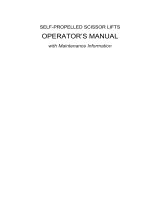
Operator's Manual Third Edition • Second Printing
18 GR-12 • GR-15 • GR-20 Part No. 97779
FUNCTION TESTS
22 Press and hold the function enable switch.
Slowly move the control handle in the direction
indicated by the yellow arrow.
Result: The platform should lower. The descent
alarm should sound while the platform is
lowering.
Test the Steering
Note: When performing the steer and drive function
tests, stand in the platform facing the steer end of
the machine.
23 Press the drive function select
switch.
24 Press and hold the function enable
switch on the control handle.
25 Press the thumb rocker switch on top of the
control handle in the direction indicated by the
blue triangle on the control panel.
Result: The steer wheels should turn in the
direction that the blue triangle points on the
control panel.
26 Press the thumb rocker switch in the direction
indicated by the yellow triangle on the control
panel.
Result: The steer wheels should turn in the
direction that the yellow triangle points on the
control panel.
Test Drive and Braking
27 Press and hold the function enable switch on the
control handle.
28 Slowly move the control handle in the direction
indicated by the blue arrow on the control panel
until the machine begins to move, then return
the handle to the center position.
Result: The machine should move in the
direction that the blue arrow points on the
control panel, then come to an abrupt stop.
29 Slowly move the control handle in the direction
indicated by the yellow arrow on the control
panel until the machine begins to move, then
return the handle to the center position.
Result: The machine should move in the
direction that the yellow arrow points on the
control panel, then come to an abrupt stop.
Note: The brakes must be able to hold the machine
on any slope it is able to climb.
Test the Tilt Sensor Operation
Note: Perform this test from the ground with the
platform controller. Do not stand in the platform.
30 Press the lift function select button.
31 Fully lower the platform.
32 Place a 2x4 or similar piece of wood in front of
each wheel on one side of the machine.
33 Press the drive function select button.
34 Drive the machine up onto both pieces of wood.
35 Press the lift function select button.





















